Haruna Yunusa
DualKanbaFormer: Kolmogorov-Arnold Networks and State Space Model Transformer for Multimodal Aspect-based Sentiment Analysis
Aug 30, 2024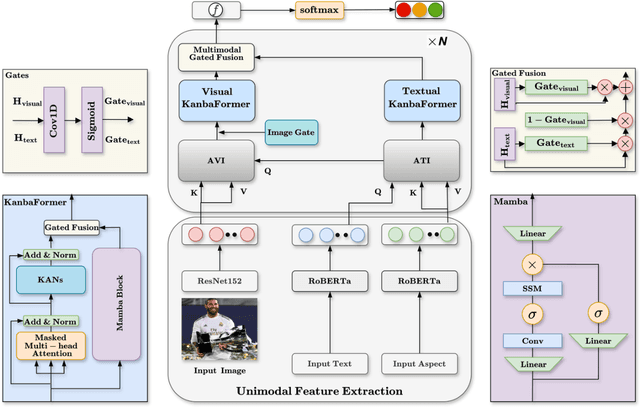
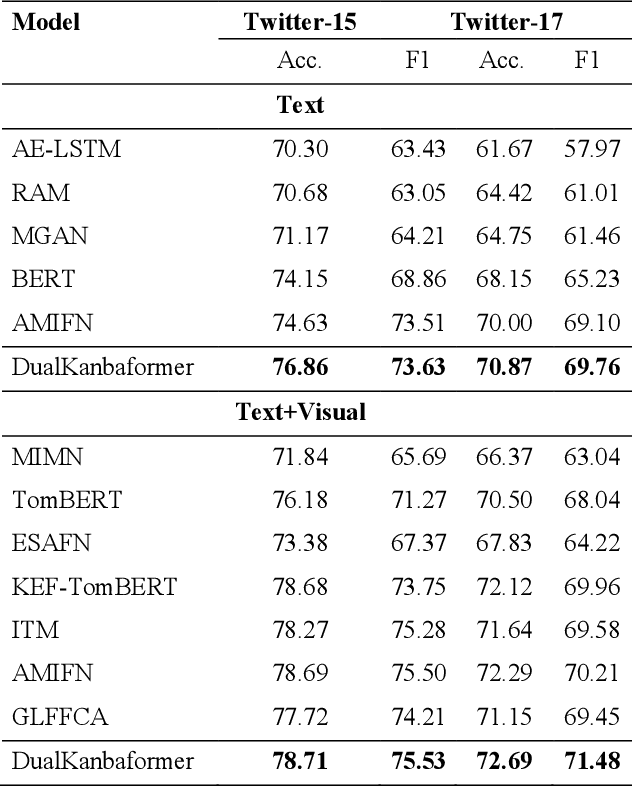
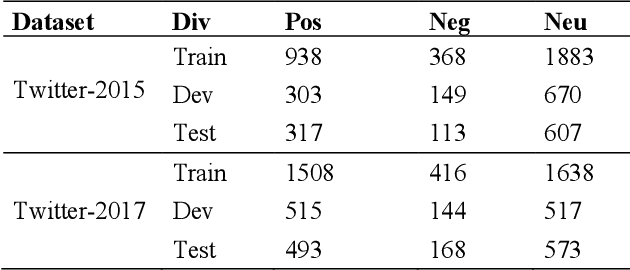
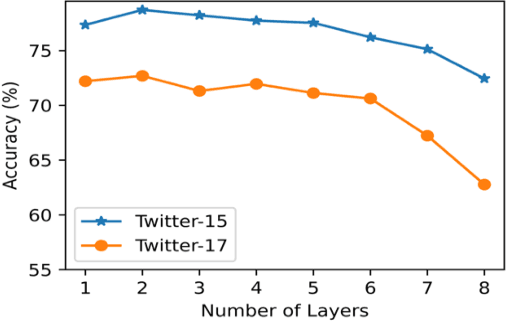
Abstract:Multimodal aspect-based sentiment analysis (MABSA) enhances sentiment detection by combining text with other data types like images. However, despite setting significant benchmarks, attention mechanisms exhibit limitations in efficiently modelling long-range dependencies between aspect and opinion targets within the text. They also face challenges in capturing global-context dependencies for visual representations. To this end, we propose Kolmogorov-Arnold Networks (KANs) and Selective State Space model (Mamba) transformer (DualKanbaFormer), a novel architecture to address the above issues. We leverage the power of Mamba to capture global context dependencies, Multi-head Attention (MHA) to capture local context dependencies, and KANs to capture non-linear modelling patterns for both textual representations (textual KanbaFormer) and visual representations (visual KanbaFormer). Furthermore, we fuse the textual KanbaFormer and visual KanbaFomer with a gated fusion layer to capture the inter-modality dynamics. According to extensive experimental results, our model outperforms some state-of-the-art (SOTA) studies on two public datasets.
KonvLiNA: Integrating Kolmogorov-Arnold Network with Linear Nyström Attention for feature fusion in Crop Field Detection
Aug 23, 2024Abstract:Crop field detection is a critical component of precision agriculture, essential for optimizing resource allocation and enhancing agricultural productivity. This study introduces KonvLiNA, a novel framework that integrates Convolutional Kolmogorov-Arnold Networks (cKAN) with Nystr\"om attention mechanisms for effective crop field detection. Leveraging KAN adaptive activation functions and the efficiency of Nystr\"om attention in handling largescale data, KonvLiNA significantly enhances feature extraction, enabling the model to capture intricate patterns in complex agricultural environments. Experimental results on rice crop dataset demonstrate KonvLiNA superiority over state-of-the-art methods, achieving a 0.415 AP and 0.459 AR with the Swin-L backbone, outperforming traditional YOLOv8 by significant margins. Additionally, evaluation on the COCO dataset showcases competitive performance across small, medium, and large objects, highlighting KonvLiNA efficacy in diverse agricultural settings. This work highlights the potential of hybrid KAN and attention mechanisms for advancing precision agriculture through improved crop field detection and management.
MambaForGCN: Enhancing Long-Range Dependency with State Space Model and Kolmogorov-Arnold Networks for Aspect-Based Sentiment Analysis
Jul 14, 2024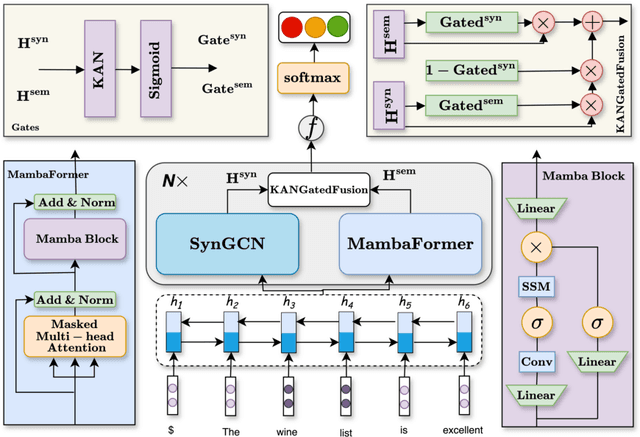
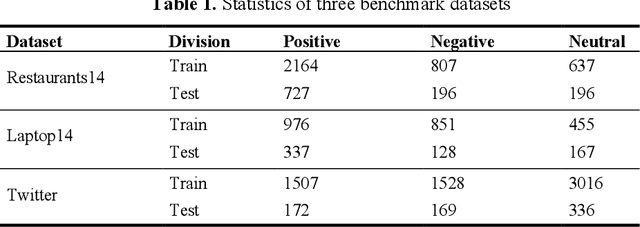
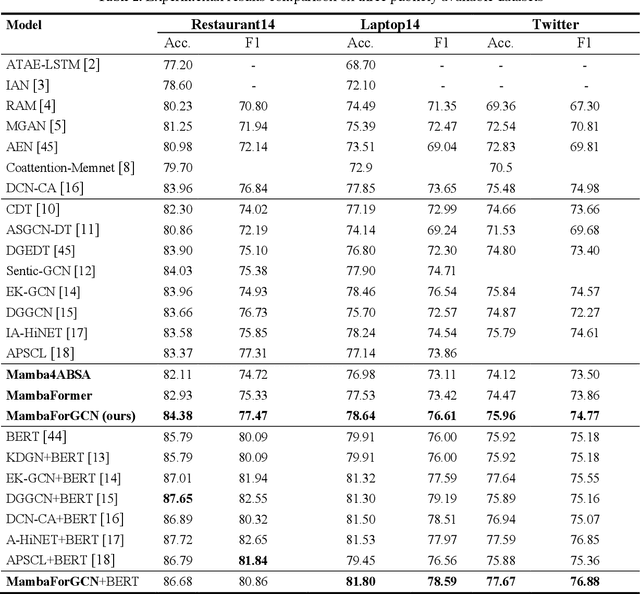
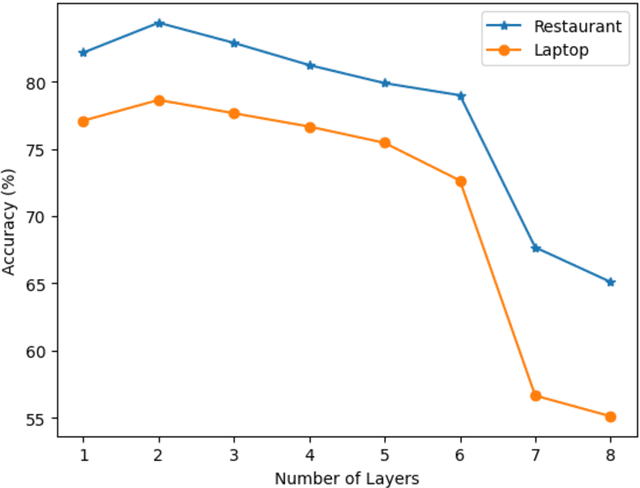
Abstract:Aspect-based sentiment Analysis (ABSA) identifies and evaluates sentiments toward specific aspects of entities within text, providing detailed insights beyond overall sentiment. However, Attention mechanisms and neural network models struggle with syntactic constraints, and the quadratic complexity of attention mechanisms hinders their adoption for capturing long-range dependencies between aspect and opinion words in ABSA. This complexity can lead to the misinterpretation of irrelevant con-textual words, restricting their effectiveness to short-range dependencies. Some studies have investigated merging semantic and syntactic approaches but face challenges in effectively integrating these methods. To address the above problems, we present MambaForGCN, a novel approach to enhance short and long-range dependencies between aspect and opinion words in ABSA. This innovative approach incorporates syntax-based Graph Convolutional Network (SynGCN) and MambaFormer (Mamba-Transformer) modules to encode input with dependency relations and semantic information. The Multihead Attention (MHA) and Mamba blocks in the MambaFormer module serve as channels to enhance the model with short and long-range dependencies between aspect and opinion words. We also introduce the Kolmogorov-Arnold Networks (KANs) gated fusion, an adaptively integrated feature representation system combining SynGCN and MambaFormer representations. Experimental results on three benchmark datasets demonstrate MambaForGCN's effectiveness, outperforming state-of-the-art (SOTA) baseline models.
iiANET: Inception Inspired Attention Hybrid Network for efficient Long-Range Dependency
Jul 10, 2024Abstract:The recent emergence of hybrid models has introduced another transformative approach to solving computer vision tasks, slowly shifting away from conventional CNN (Convolutional Neural Network) and ViT (Vision Transformer). However, not enough effort has been made to efficiently combine these two approaches to improve capturing long-range dependencies prevalent in complex images. In this paper, we introduce iiANET (Inception Inspired Attention Network), an efficient hybrid model designed to capture long-range dependencies in complex images. The fundamental building block, iiABlock, integrates global 2D-MHSA (Multi-Head Self-Attention) with Registers, MBConv2 (MobileNetV2-based convolution), and dilated convolution in parallel, enabling the model to adeptly leverage self-attention for capturing long-range dependencies while utilizing MBConv2 for effective local-detail extraction and dilated convolution for efficiently expanding the kernel receptive field to capture more contextual information. Lastly, we serially integrate an ECANET (Efficient Channel Attention Network) at the end of each iiABlock to calibrate channel-wise attention for enhanced model performance. Extensive qualitative and quantitative comparative evaluation on various benchmarks demonstrates improved performance over some state-of-the-art models.
M2ANET: Mobile Malaria Attention Network for efficient classification of plasmodium parasites in blood cells
May 23, 2024Abstract:Malaria is a life-threatening infectious disease caused by Plasmodium parasites, which poses a significant public health challenge worldwide, particularly in tropical and subtropical regions. Timely and accurate detection of malaria parasites in blood cells is crucial for effective treatment and control of the disease. In recent years, deep learning techniques have demonstrated remarkable success in medical image analysis tasks, offering promising avenues for improving diagnostic accuracy, with limited studies on hybrid mobile models due to the complexity of combining two distinct models and the significant memory demand of self-attention mechanism especially for edge devices. In this study, we explore the potential of designing a hybrid mobile model for efficient classification of plasmodium parasites in blood cell images. Therefore, we present M2ANET (Mobile Malaria Attention Network). The model integrates MBConv3 (MobileNetV3 blocks) for efficient capturing of local feature extractions within blood cell images and a modified global-MHSA (multi-head self-attention) mechanism in the latter stages of the network for capturing global context. Through extensive experimentation on benchmark, we demonstrate that M2ANET outperforms some state-of-the-art lightweight and mobile networks in terms of both accuracy and efficiency. Moreover, we discuss the potential implications of M2ANET in advancing malaria diagnosis and treatment, highlighting its suitability for deployment in resource-constrained healthcare settings. The development of M2ANET represents a significant advancement in the pursuit of efficient and accurate malaria detection, with broader implications for medical image analysis and global healthcare initiatives.
Exploring the Synergies of Hybrid CNNs and ViTs Architectures for Computer Vision: A survey
Feb 05, 2024Abstract:The hybrid of Convolutional Neural Network (CNN) and Vision Transformers (ViT) architectures has emerged as a groundbreaking approach, pushing the boundaries of computer vision (CV). This comprehensive review provides a thorough examination of the literature on state-of-the-art hybrid CNN-ViT architectures, exploring the synergies between these two approaches. The main content of this survey includes: (1) a background on the vanilla CNN and ViT, (2) systematic review of various taxonomic hybrid designs to explore the synergy achieved through merging CNNs and ViTs models, (3) comparative analysis and application task-specific synergy between different hybrid architectures, (4) challenges and future directions for hybrid models, (5) lastly, the survey concludes with a summary of key findings and recommendations. Through this exploration of hybrid CV architectures, the survey aims to serve as a guiding resource, fostering a deeper understanding of the intricate dynamics between CNNs and ViTs and their collective impact on shaping the future of CV architectures.
 Add to Chrome
Add to Chrome Add to Firefox
Add to Firefox Add to Edge
Add to Edge